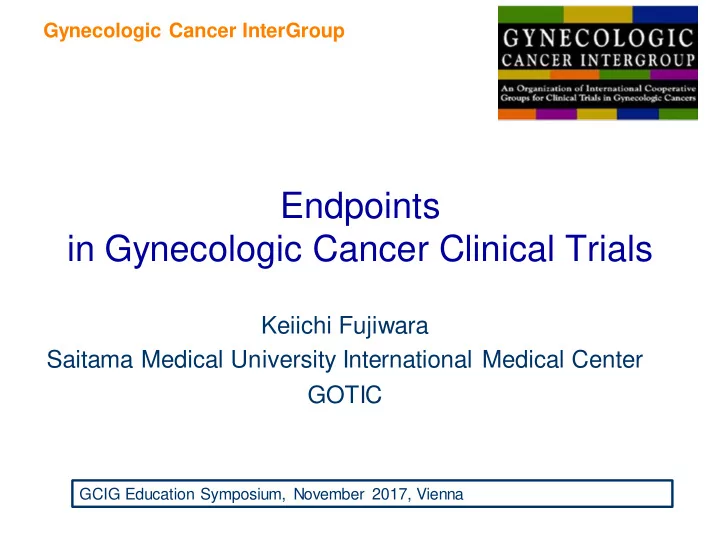

Gynecologic Cancer InterGroup Endpoints in Gynecologic Cancer Clinical Trials Keiichi Fujiwara Saitama Medical University International Medical Center GOTIC GCIG Education Symposium, November 2017, Vienna
Gynecologic Cancer InterGroup • AGENDA – Definition of Endpoint – Variation of Endpoint • Primary vs Secondary • Direct vs Surrogate – Suitable Endpoints for Gynecologic Cancer Clinical Trials from 5th OCCC • 1st Line • Recurrent Setting GCIG Education Symposium, November 2017, Vienna
Gynecologic Cancer InterGroup • AGENDA – Definition of Endpoint – Variation of Endpoint • Primary vs Secondary • Direct vs Surrogate – Suitable Endpoints for Gynecologic Cancer Clinical Trials from 5th OCCC • 1st Line • Recurrent Setting GCIG Education Symposium, November 2017, Vienna
Gynecologic Cancer InterGroup • Endpoint – Goal/Purpose of Clinical Trial – Depends on the Phase of Clinical Trial • Phase 1 – Safety • Phase 2 – Efficacy & Safety in Selective number of Patients • Phase 3 – True Efficacy GCIG Education Symposium, November 2017, Vienna
Gynecologic Cancer InterGroup Endpoint of Phase I Trial • To determine – Maximum Tolerable Dose (MTD) for the future trial • Whether or not the patient experiences a dose limiting toxicities (DLT) – Recomended Dose for Phase 2 Trials GCIG Education Symposium, November 2017, Vienna
Gynecologic Cancer InterGroup Endpoint of Phase I Trial • How? – The Traditional 3+3 Design • Too many patients with lower doses than MTD – Alternative Trial Designs such as Continuous Reassessment Model (CRM) • To accelerate the process • Good for Biologic Agents with low toxicity profiles GCIG Education Symposium, November 2017, Vienna
Gynecologic Cancer InterGroup Endpoint of Phase 2 Trial • To Provide – The testing ground for the development of definitive Phase 3 trials • Through the screening of new agents for antitumor activity • By piloting new treatment combination and schedules. • Limitation – Small sample size compromising in Type I and II error cannot draw definitive conclusion GCIG Education Symposium, November 2017, Vienna
Gynecologic Cancer InterGroup Endpoint of Phase 2 Trial • How? – Single-Arm Phase 2 Designs – Muli-Arm Phase 2 Designs • Basket Trials • Umbrella Trials • Using Short-Term Endpoints – Tumor Response for Cytotoxic Agents – 6-Month Survival for Target Therapies • Little Impact on Tumor Shrinkage • Tumor Stabilization as a Main Effect GCIG Education Symposium, November 2017, Vienna
Gynecologic Cancer InterGroup Endpoint of Phase 3 Trial • To Compare the results with the Standard Therapy for – Superiority • Efficacy – OS – PFS – Equivalence or Noninferiority • Safety • PRO QOL • Cost-Benefit GCIG Education Symposium, November 2017, Vienna
Gynecologic Cancer InterGroup • AGENDA – Definition of Endpoint – Variation of Endpoint • Primary vs Secondary • Direct vs Surrogate – Suitable Endpoints for Gynecologic Cancer Clinical Trials from 5th OCCC • 1st Line • Recurrent Setting GCIG Education Symposium, November 2017, Vienna
Gynecologic Cancer InterGroup Primary vs Seconcary Endpoint for P3 • Primary – OS or PFS for Superiority Trial • Secondary – Safety – PRO QOL – Cost-Benefit GCIG Education Symposium, November 2017, Vienna
Gynecologic Cancer InterGroup Surrogate Endpoints • Although OS is the preferred primary endpoint – Not suitable in trials that takes longer time for diseases with good prognosis. • Need endpoint that can surrogate OS – Which can measure with shorter time. • Such as PFS or Tumor Response GCIG Education Symposium, November 2017, Vienna
Hazard Ratios of PFS vs. OS: Data from Platinum-based Chemotherapy Trials in Advanced OVCA 1.2 1.1 Line of 1.0 identity PFS HR 0.74 (11.5 15.5 mo = gain 4 mo) OS HR 0.73 (25.8 35.6 mo = gain 11.8 mo) OS 0.9 0.8 Linear Regression lnHR os =1.01*lnHR PFS -0.006 R 2 =0.91 0.7 0.6 0.6 0.7 0.8 0.9 1.0 1.1 1.2 PFS
Hazard Ratios of PFS vs. OS: Data from RCTs of Bevacizumab in Other Solid Tumors OS improvement at 1.1 least 2 months less than that for PFS 1.0 0.9 OS 0.8 Linear Regression 0.7 lnHR os =0.67*lnHR PFS +0.09 R 2 =0.61 0.6 0.5 0.5 0.6 0.7 0.8 0.9 1.0 1.1 PFS
Gynecologic Cancer InterGroup Surrogate Endpoint • Most useful in the context of Phase 2 trials, to screen agents for further randomized testing of effects on primary true endpoints. GCIG Education Symposium, November 2017, Vienna
Gynecologic Cancer InterGroup • AGENDA – Definition of Endpoint – Variation of Endpoint • Primary vs Secondary • Direct vs Surrogate – Suitable Endpoints for Gynecologic Cancer Clinical Trials from 5th OCCC • 1st Line • Recurrent Setting GCIG Education Symposium, November 2017, Vienna
Gynecologic Cancer InterGroup From 5 th OCCC • Trial Endpoints for 1 st line intervention trial – OS is the preferred primary endpoint with or without a maintenance component. – PFS is an alternative primary endpoint, but if PFS is chosen OS must be measured as a secondary endpoint – PFS must be supported by additional endpoints, including • Predefined PRO • Time to first or second subsequent therapy. GCIG Education Symposium, November 2017, Vienna
Gynecologic Cancer InterGroup From 5 th OCCC • Trial Endpoints for 1 st line intervention trial – The increasing use of neoadjuvant chemotherapy provides opportunities for short-term trials to evaluate novel treatments prior to surgery – Translational endpoints in these ‘window of opportunity’ studies need to be better defined and validated. GCIG Education Symposium, November 2017, Vienna
Gynecologic Cancer InterGroup From 5th OCCC • Trial Endpoint in ROC – OS is the preferred endpoint for patient cohorts with an expected median OS < 12 months. – PFS is an alternative, and it is the preferred endpoint when the expected median OS is >12 months. – However, PFS alone should not be the only endpoint and must be supported by additional endpoints • PRO: Patient Reported Outcomes • TSST: Time to Second Subsequent Therapy • TUDD: time until definitive deterioration of quality of life GCIG Education Symposium, November 2017, Vienna
Thank You !!
Recommend
More recommend